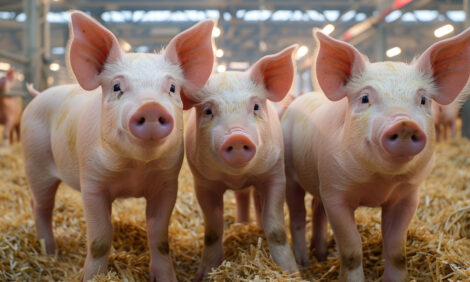



NADIS/BPEX Commentary - Respiratory Diseases
Pig veterinarian, Mark White, reports the results of a survey by UK vets into the incidence of respiratory diseases in growing pigs in the UK in the November 2008 issue of NADIS/BPEX Commentary.Veterinary surgeons undertaking clinical visits to pig farms record the prevalence of a range of syndromes and conditions seen and these are reported through the NADIS system.
With background data on the farms such as farm type, location, size and management systems also recorded, it is possible to make associations between these various parameters and disease conditions.
Respiratory disease has dominated the health picture on many pig farms in the UK over the last few decades. However, long gone are the days of uncomplicated enzootic pneumonia and secondary bacterial invasion (e.g. with Pasturella and Bordetella) or primary pleuropneumonia. Since the mid 1980’s a range of respiratory viruses have complicated the picture either acting as triggers or opportunists of other agents. Thus we are now faced, on large numbers of farms, with enzootic (endemic) PRRS, PCV2 respiratory coronavirus and intermittently a range of Swine Influenza strains. The complicated picture has to some extent been offset by the development of effective vaccines against specific agents (Mycoplasma, PRRS, Acpp and most recently PCV2).
The NADIS monitoring system, based on veterinary surgeon assessment of prevalence of disease, makes no attempt to separate these different agents relying on a diagnosis of the syndrome of respiratory disease often characterised as Porcine Respiratory Disease Complex (PRDC).

Graph 1 highlights the picture over the last 18 months with a cyclical pattern of disease emerging, the low points appearing to be mid-summer and mid-winter whilst the more variable spring and autumn unsurprisingly record upsurges.


However, the picture appears to change in weaners this year with an earlier and more dramatic fall in respiratory disease which is not as clearly mirrored in growers/finishers (graphs 2 & 3). This suggests that it is more than just weather effects and coincides with the widespread introduction of PCV2 vaccine in the spring, in part associated with the BPEX funded research programme.
If this is truly the cause of falling levels of disease – which have halved in prevalence- such improvements would be expected to appear in older pigs as vaccine works its way through. Clinical monitoring will work in parallel with abattoir monitoring to identify improvements in these growers and finishers.

With respect to system variations a number of interesting patterns have emerged over the last 12 months. In the hot summer of 2007 respiratory disease in straw based finishers spiked and produced prevalence higher than that seen on slatted accommodation. That does not appear to have happened in 2008, presumably due to the lack of any extreme hot weather (graph 4). Rather worryingly over the year respiratory disease prevalence in batch systems is 60% higher than in continuous flow systems, the opposite of what is expected. It is not possible to identify whether vaccine uptake has been higher or earlier in continual flow systems, from NADIS data, which might account for this difference.
Even more dramatic is the difference in prevalence between the two principal pig keeping areas with East Anglia recording a prevalence of respiratory disease five times that of North East England (graph 5). This may tie in with the batch/continuous flow dichotomy, with batch system favoured in East Anglia.

Prevalence of respiratory disease varies with size of herd with the largest feeding herd populations (more than 8000 pigs/site) recording approximately 2.5 times the level of disease seen in smaller units (graph 6). Environmental load of infection clearly must be playing a part and it is reasonable to expect that the effects of intervention (e.g. introduction of PCV2 vaccine) might be slower to be realised in these larger herds than in a smaller and more discrete population.

November 2008








